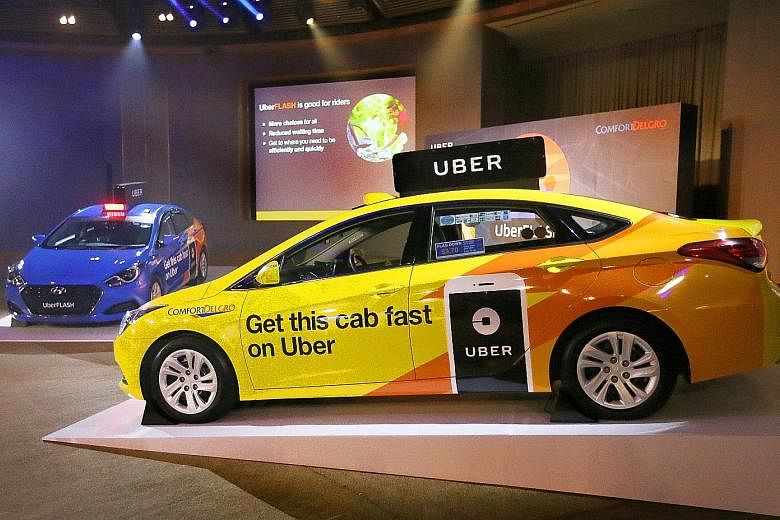It has long been illegal for taxi operators to allocate rides through bidding - a covert system where commuters who are willing to pay more get assigned a cab. Yet this ad hoc auction, where some touts would guarantee a cab on a rainy Friday evening for a few dollars more, is what surge pricing really amounts to.
But in the case of surge pricing, the "few dollars more" can amount to three or four times the normal fare. It is not uncommon to hear of a 10km ride costing $40-$50.
And during a major rail breakdown - such as the one which crippled the North-South and East-West lines in July 2015 - irate Uber customers complained of fares exceeding $100. Having to fork out five times the normal taxi fare - or in the case of displaced train commuters, 80 times their usual MRT fare - is not something anyone relishes.
It is therefore quite understandable that the Land Transport Authority (LTA) had always frowned upon the practice of taxi-booking "touts" asking for more money to secure a ride during peak periods.
Nonetheless, the practice continued, even if not openly. In September 2012, The Straits Times reported on at least nine "independent service operators" offering this permutation of dynamic pricing.
The LTA was irrevocably against it, describing the practice as "unauthorised and illegal". This attitude changed dramatically barely a year later in 2013, when Uber and Grab entered the fray.
Back then, the LTA said that Uber and Grab were not transport providers, but technology companies. But it has since become clear to observers the world over that the two are no different from taxi operators. They are transport providers, albeit ones with technology.
And now, ComfortDelGro, Singapore's largest taxi group, is teaming up with Uber to launch UberFlash, which will offer the option of surge pricing.
So, what is so wrong with surge pricing? In itself, nothing.
Economists will readily point out that pricing is the best method of resource allocation when demand is high. It has been practised widely by several other industries. Anyone who has tried booking an air ticket during the December holidays can attest to that.
But that principle cannot and should not be applied to basic amenities like water, power and public transport. Demand for these goods and services tend to be fairly inelastic. And often, providers enjoy a captive market.
So, while condoning dynamic pricing for public transport may be economically sound, it is socially inequitable.
Of course, the question now turns to whether policymakers view taxi and taxi-like services as public transport. At best, their stand is hazy. Until recently, the LTA's public transport ridership statistics included taxi rides. At the same time, a page on the regulator's website says that "taxis bridge the gap between commuting and driving a car... taxis offer a choice for commuters who wish to have a personalised and convenient door-to-door service".

Still, any layman will instinctively term taxis as public transport, since a cab commuter does not have exclusive use of any one cab. A taxi is used by tens of thousands of people in its lifetime.
At its height, the taxi industry here had 28,000 cabs, which accounted for over one million rides a day. There is no ridership figure for private-hire cars. But given that their population is more than double that of cabs, an estimated ridership of two million would not be unrealistic. Combine that with taxi rides,and they account for a combined daily ridership of 2.5 million to three million - close to what the MRT carries a day. That certainly does not sound like private transport.
On a day-to-day basis, the undesirability of surge pricing may not be obvious now because consumers currently have a choice. They still have access to taxis with fixed and transparent fares. But this situation may not continue for long. The writing is already on the wall.
ComfortDelGro - which recently ran a huge ad campaign with the tagline "No Surge Pricing" - is now offering dynamic fares through UberFlash.
What happens when cabbies discover that it is more profitable to go on the surge pricing booking platform? Clearly, they will game the system to maximise their chances of getting the highest fares in the shortest time. Commuters will remember the "hide-and-seek" tactics cabbies used during evening peak and just before the midnight hour.
The possibility of significantly higher fares aside, there is another negative element to surge pricing - opaqueness. How will commuters know when surge pricing is justified at any given point in time?
Indeed, the industry could eventually evolve into one which serves only the well-to-do and those with an expense account if it is left unchecked. In any other market, that may well be fine. But in Singapore, cab fares have been "affordable" for the longest time for one unspoken political reason: cars are beyond the reach of the majority.
Have policymakers changed their stance? It would seem so, given the regulatory concessions private-hire players enjoy. In this increasingly laissez-faire market, there can only be one outcome: higher fares, and an increasing disenchantment among the masses denied access to the next best thing to a car.
One could argue that competition will see to it that this does not happen. But going by what we see in other industries, competition is not always perfect. Often, dominant players are able to set the price they wish to charge, and the rest of the market follows.
Hence, if Singapore considers taxis and taxi equivalents as providers of an essential service, it must continue to regulate them tightly.


